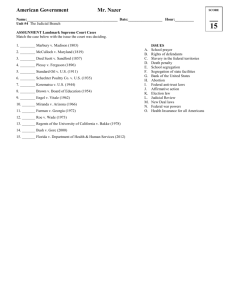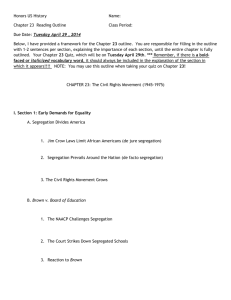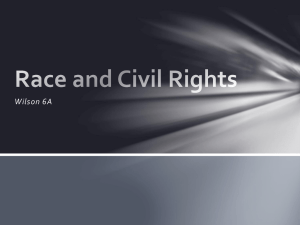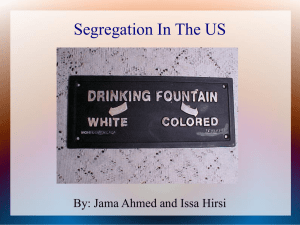File - Christina Odom's E
advertisement
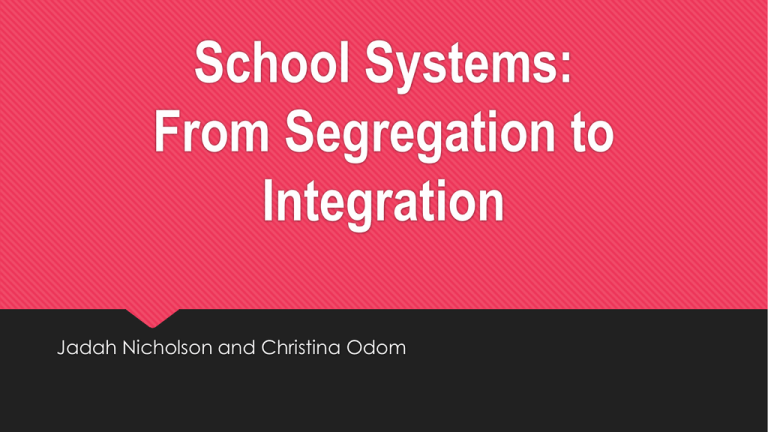
School Systems: From Segregation to Integration Jadah Nicholson and Christina Odom Segregation The practice or policy of creating separate facilities within the same society for the use of a minority group “Racial segregation was a system derived from the efforts of white Americans to keep African Americans in a subordinate status by denying them equal access to public facilities and ensuring that blacks lived apart from whites.” (Lawson) The Supreme Court ruled in the 1857 case of Dred Scott v. Sanford that African-Americans weren’t considered U.S. citizen which led to the exclusion of blacks from many places These exclusions included public transportation, hotels, restaurants, theaters, and schools Integration The act of combining or adding parts to make a unified whole A change to make a difference in the world and see everyone as equal and whole In 1964, President Lyndon B. Johnson passed the Civil Rights Act of 1964 abolishing discrimination in education, public facilities, and voting. The voter rights act was passed in 1965 but there was still controversy among blacks being able to integrate and be independent In 1970, black college students started to attend what used to be previous white colleges Segregation in the Schools Segregation in the world around was not limited to schools White and black children went to separate schools The quality of the education of white children seemed to be more important than that of black children White children often had better working environments and better educational tools while black children basically received rags Even though black children’s education wasn’t considered as important to most people, some chose to fight for their rights to an equal education The events that took place paved the way to the equal education children receive today (McClure) Black Classroom What do you notice? No desks Students are not sitting on individual seats Students are sharing a couple of books Classroom looks messy Classroom looks dirty Looks like a poor school School for colored people (“Separate but Equal”) White Classroom What do you notice in this picture? Student has room to work on a desk Student has an individual seat Student has their own textbook Classroom has a map on the wall Classroom looks neat and organized (Phillips) Segregation becomes Unconstitutional May 17, 1954 Brown v. Board of Education "Separate educational facilities are inherently unequal.“ ("American Civil Liberties Union.“) http://www.youtube.com/watch?v=J sZcEHFhWOA (Rivas) “The Greensboro Four” Joseph McNeil, Ezell Blair, Jr., Franklin McCain, David Richmond Four men that attended NC A&T got tired of segregation Decided to make a change by protesting at the all white Woolworth Diner One of the major starting points of integration Made a difference in the Civil Rights Movements just as Linda and Oliver Brown, Ruby Bridges, the Little Rock Nine, and many others (McClure) Brown v. Board of Education Linda Brown-African-American 3rd grader Oliver Brown, father, felt school she attended was not equal to the white schools in her neighborhood Father sued the school in hopes that Linda would be granted an equal education May 17, 1954, the Supreme Court announced that separate was not equal. (“Brown v. Board of Education”) “Little Rock Nine” September 4, 1957 Involved Govenor Orval Faubus prevented nine students from entering Little Rock Central High School Ernest Green, Elizabeth Eckford, Jefferson Thomas, Terrence Roberts, Carlotta Walls Lanier, Minnijean Brown Trickey, Gloria Ray Karlmark, Thelma Mothershed-Wair, Melba Pattillo Beals Called "the most severe test of the Constitution since the Civil War." (“Little Rock Central”) (“Little Rock Central”) Integration in the Schools: Ruby Bridges First black child to attend all-white elementary school November 14, 1960 New Orleans William Frantz Elementary School Six Years Old Mrs. Henry (Bridges) U.S. Kids Not So Good At Math Compares the school system and the difference between the quality of education One child going to school plus another child going to school should equal two children that are ready for the work force Notice, one white child going to school plus one black child going to school equals to one educated child Can you guess which child is prepared for the future. (Bendib) High Court Bans School Segregation On May 17, the Supreme Court outlawed the view that separate was equal in the schools system This law put a ending to segregation in schools in twenty one states and in the District of Columbia Was a 9-0 decision Discussed that segregation in schools withdraws the children from having equal educational opportunities (Huston) Significant Supreme Court Cases Involving Segregation in Schools 1968-Green v. New Kent County, Va.: found the state’s “freedom of choice” plans ineffective at producing actual school desegregation. The Court says that school officials have an affirmative duty to eliminate segregation “root and branch.” Justices introduce the principle of “achieving unitary status,” or a racially nondiscriminatory system. 1971-Swann v. Charlotte-Mecklenberg Board of Education, N.C.: provided judges with broad power to fashion remedies to racial segregation if school districts fail to do so. Decision allowed the busing of white and black students and redrawing school district lines to end segregation of schools. 1973-Keyes v. School District No. 1, Denver: ruled that schools have responsibility to desegregate, even in districts where schools had not been segregated by law. Limited remedies courts can fashion for school districts that did not have laws requiring racially segregated schools. 1974-Milliken v. Bradley: curtailed the power of judges to impose area-wide remedies, such as forced busing, on one school district to address racial segregation in another. Significant Supreme Court Cases Involving Segregation in Schools Cont’d 1978-Regents of the University of California v. Bakke: struck down on racial quotas but embraced the concept of affirmative action by saying admissions policies can take race into account. 1991-Board of Education of Oklahoma City v. Dowell: made it easier for school districts to abandon forced busing of students once racial desegregation was achieved, even if it resulted in a return to racially segregated schools. 1992-Freeman v. Pitts: ruled that courts could end supervision of aspects of desegregation plans once segregated school districts achieve integration incrementally. 2000-Hopwood v. Texas: refused to consider a lower court ruling that says developing a racially or ethnically diverse student body could not serve as a legitimate governmental reason for implementing a race-based admissions policy. 2003-Gratz v. Bollinger and Grutter v. Bollinger: banned the use of rigid formulas that award points based on race for admission to the University of Michigan’s undergraduate program and law school. But the court permited colleges to consider race as part of a “holistic review” of every application. Benefits of Integration in Schools Provides the opportunity to interact with those of a different culture and race Helps students view more cultures Has an effect on students racial attitudes Lessens the racial stereotypes or discrimination that one may face (Shen) Is It Me or The Books? by Chiliyah Leak Talking about a place for education Not a place where it's segregation What does my race say compared to these whites? I'm not dedicated? Just because there is a darker pigment on my skin don't mean that my intelligence is thin See what you don't understand is that I have the strive and ambition just as much as anybody else! But I still get these old torn books on broken shelves? Is there a reason that I get looks when I can quote a book? Or how about when I can do a math problems, and it's even hard for teachers to solve them! What's the difference between me and them? I'm not just somebody who can shoot a ball in the gym? It's funny because I'm actually working for mine, and these so called intelligent whites getting slaps on the behind! So yes I'm getting this education And nothing will stop me, specially segregation. Segregation Still Exists Today http://youtu.be/cb0sg6zXKhM Wilcox County High School *Wilcox County, GA This news report discusses how some students stood up at a local high school to enforce it’s first integrated prom. Students felt as if there was no need for two separate proms because they all get along equally. This also shows that even though segregation was demolished, it still exists in some places today. (Daniels) Diversity Close to Home Though the majority of the population at this school seems to predominantly be white, there is also a strong population which proves that integration is effective in 2013. (“College Search”) In Conclusion…. From looking at the different groups of people and cases who took a stand against segregation in schools, we can see that the integration of schools has progressed throughout the years However, in some small towns, segregation still heavily exists. As we look at observations from different surroundings, we see that those of the same race are not restricted to but still cling to their own. Works Cited "American Civil Liberties Union." American Civil Liberties Union. ACLU, 8 Feb. 2007. Web. 16 July 2013. Associated Press. "Highlights of Significant Supreme Court Cases on Race and Schools." - Higher Education. DiverseEducation.com, 29 June 2007. Web. 16 July 2013. Bendib, Khalil. "School Resegregation." OtherWords. N.p., 12 Apr. 2013. Web. 16 July 2013. Bridges, Ruby. "Ruby Bridges | The Story." Ruby Bridges | The Story. Guideposts, Mar. Web. 23 July 2013. "Brown v. Board of Education." Brown v. Board of Education. N.p., n.d. Web. 2000. 16 July 2013. "Brown v. Board of Education: Where Have We Been, Where Are We Now, and Where Are We Going?" Www.Brown@50.org. N.p., n.d. Web. 16 July 2013. "College Search - University of North Carolina at Charlotte - UNC at Charlotte." College Search University of North Carolina at Charlotte - UNC at Charlotte. The College Board, n.d. Web. 16 July 2013. Works Cited, Cont’d Daniels, Antonio M. "Revolutionary Paideia." Revolutionary Paideia. N.p., 7 Apr. 2013. Web. 16 July 2013. Faison, Latorial. "African American Poetry by Latorial Faison: Ruby Bridges' Brave Step." African American Poetry by Latorial Faison: Ruby Bridges' Brave Step. N.p., 8 Nov. 2012. Web. 24 July 2013. "Greensboro Sit-In and the Sit-In Movement." History.com. A&E Television Networks, n.d. Web. 16 July 2013. Huston, Luther A. "High Court Bans School Segregation; 9-to-0 Decision Grants Time to Comply." The New York Times On The Web. N.p., 18 May 1954. Web. 16 July 2013. Johnston, Phillip. “A New Era Dawns for the Grammar School.” The Telegraph. 26 Mar. 2012. Web Lawson, Stephen F. "Segregation, Freedom's Story, TeacherServe®, National Humanities Center." Segregation, Freedom's Story, TeacherServe®, National Humanities Center. National Humanities Center, n.d. Web. 16 July 2013. "Little Rock Central High School National Historic Site." www.nps.gov. N.p., n.d. Web. 16 July 2013. Works Cited, Cont’d McClure, Brian. "State of HBCUs." State of HBCUs. N.p., 1 Feb. 2012. Web. 16 July 2013. "Rivas, Jorge. "May 17, 1954: Supreme Court Rules Racial Segregation in Schools Unconstitutional - COLORLINES." RSS. Colorlines.com, 17 May 2013. Web. 16 July 2013. "Ruby Bridges Biography." Bio.com. A&E Networks Television, n.d. Web. 23 July 2013. “Separate but Equal: West Memphis 1948.” - Arkansaw Traveler. Web. 23 July 2013 Shen, Ann. The New York Times. The New York Times Company, 28 May 2012. Web. 16 July 2013 "The Little Rock Nine." The Little Rock Nine. N.p., n.d. Web. 16 July 2013.
